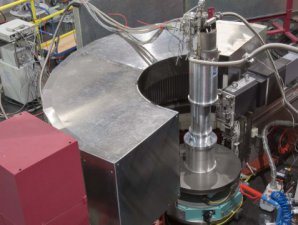Superstructure in Heusler alloys discovered
Scientists determine the structure of shape memory alloys of nickel-manganese-indium. They have received NMI3 support to conduct experiments at MLZ through the Rapid Access Program.
26/03/2015

SPODI was the instrument which helped reveal the structure of Heusler alloys. © W. Schürmann, TUM.
Thanks to NMI3 support scientists could conduct an experiment with the instrument SPODI at the Heinz Maier-Leibnitz Zentrum (MLZ) in Germany to determine the structure of shape memory alloys of nickel-manganese-indium. These alloys have become very interesting in recent years because of their special properties: they have a shape memory which can be changed by a magnetic field. This behaviour is mainly based on the interaction of crystal structure and magnetic order and this has implications on which application the alloy suits best.
The scientists combined high-resolution neutron diffraction at the instrument SPODI and diffraction with synchrotron radiation to investigate a Ni2Mn1.44In0.56 alloy. They thereby found a wave-like (modulated) super structure, in which the position of every sixth lattice element is identical. According to the team this superstructure is found in similar alloys of nickel, cobalt, manganese and indium, which martensitic transformation elapses near room temperature. The results contribute to a better understanding of the mechanism underlying this effect and will allow to better control the magnetic and mechanical properties of future alloys.
This experiment and fast publication of the results is an impressive achievement of the Rapid Access program at MLZ. Normally, scientists can apply twice a year for measuring time with neutrons. An expert panel evaluates these proposals, then if possible scientists are allocated the requested measurement time. However since summer 2013, access to MLZ was made quicker through the Rapid Access program. Applications through this program pass only through internal assessment and are allocated up to 3 days per cycle. Users who require neutrons as an additional characterisation method have a maximum of 12 hours for their experiment. Users have received the Rapid Access program very well with the number of applications exceeding the MLZ capacity by far. The offer is limited to the instruments SPODI, PGAA, KWS-2, and BIODIFF.
Original Publication
Haile Yan, Yudong Zhang, Nan Xu, Anatoliy Senyshyn, Heinz-Günter Brokmeier, Claude Esling, Xiang Zhaoa and Liang Zuoa (2015) Crystal structure determination of incommensurate modulated martensite in Ni–Mn–In Heusler alloys, Acta Materialia 88, 375 DOI:10.1016/j.actamat.2015.01.025

This work has received NMI3 support to conduct experiments at MLZ.
Source: MLZ news
Latest NMI3 highlights
Will we have stronger, enduring teeth? New material for tooth fillings is being investigated
Scientists used neutrons and X-rays to better understand the structure and hydration process of glass ionomer cements. This material is a promising alternative for dental fillings. To know more click here .
SANS: a unique technique to look inside plants’ leaves
Small-angle neutron scattering enabled researchers to look inside intact leaves to learn how their structure and functions change when submitted to environmental changes. To know more click here .
Egyptian statuettes of Osiris: production unveiled by neutrons and laser
A group of scientists from Italy, Germany and the United Kingdom applied an innovative approach to study Egyptian copper alloy figurines. To know more click here.



